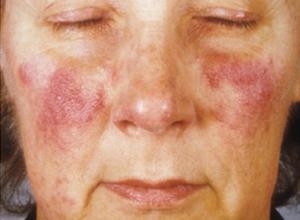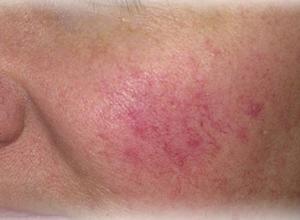Skin Condition » Rosacea
Rosacea is a chronic condition characterized by facial redness and sometimes pimple-like spots. It primarily affects Caucasians of north western European people. Rosacea affects both sexes, but is almost three times more common in women. It typically begins as redness on the central face across the cheeks, nose, or forehead, but can also less commonly affect the neck, chest, ears, and even scalp. In some cases, telangiectasia or a dilation of superficial blood vessels on the face, red domed papules (small bumps) and pustules, red gritty eyes, burning and stinging sensations, and in some advanced cases, a red lobulated nose (rhinophyma), may develop. Triggers that cause episodes of flushing and blushing play a part in the development of rosacea. Exposure to temperature extremes can cause the face to become flushed as well as strenuous exercise, heat from sunlight, severe sunburn, stress, anxiety, cold wind, and moving to a warm or hot environment from a cold one such as heated shops and offices during the winter. There are also some food and drinks that can trigger flushing, including alcohol, food and beverages containing caffeine (especially, hot tea and coffee). Some acne and wrinkle treatments that have been reported to cause rosacea include microdermabrasion and chemical peels, as well as high dosages of isotretinoin, benzoyl peroxide, and tretinoin. Steroid induced rosacea is the term given to rosacea caused by the use of topical or nasal steroids. These steroids are often prescribed for seborrheic dermatitis. Dosage should be slowly decreased and not immediately stopped to avoid flaring up. Treatment • Oral antibiotics and topical antibiotics are usually the first line of relieving papules, pustules, inflammation and some redness. Topical azelaic acid can reduce inflammatory lesions, bumps and papules as well as ocular rosacea. • Dermatological vascular laser or intense pulsed light machines offer one of the best treatments for rosacea, in particular the erythema of the skin. The laser or intense pulse light will penetrate to target hemoglobin in the capillaries. The immediate vascular removal is seen right away and the redness will reduce with time. Our clinic offers dual yellow FEM laser to treat rosacea. The wavelength 577 nm of the yellow light will specifically target the hemogloblin and will destroy small dilated blood vessles. • CO2 lasers can be used to remove excess connective tissue causing rhinophyma. • Low level light therapy has a role to reduce inflammation. Call Center : +66 618240996 Line ID : laserpremium
|















